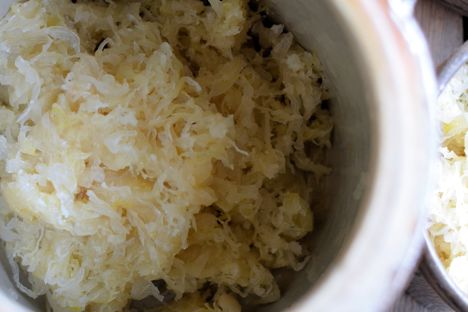Sauerkraut – literally ‘sour cabbage’ – is a fermented white cabbage dish synonymous with Eastern European cuisine. During the lacto-fermentation process, the cabbage's natural sugars are converted into amino acids and carbon dioxide, which is what gives the kraut its sour and umami flavour.
If you’re keen to have a try at fermentation at home, sauerkraut is a great place to start as it only requires two ingredients (cabbage and salt) and is very quick to prepare. Whilst the sound of cultivating bacteria may sound like a risky business, the presence of salt ensures any harmful bacteria does not survive. The ‘good’ bacteria can survive the salty environment and is said to be very good for gut health. Shop bought sauerkraut has often been pasteurized (which kills any good bacteria), which is another advantage to making your own!
When it comes to recipes, there are no firm rules in terms of length or flavourings, it's really down to personal taste. Some prefer a fresher kraut with a bit of crunch which will be ready in a matter of days, whereas a kraut fermented for months will have a deeper, tangier flavour - taste at different points in the process to determine what you prefer.
The fermenting liquid must not be overlooked! This briny solution is a great way of seasoning and injecting some umami into your dishes. Try adding to a marinade or even a bloody Mary cocktail.
Metric
Imperial
- 1 white cabbage
- 20g of salt
- 10g of sugar
- 1 tsp black peppercorns, cracked
- 1 bay leaf
Method
Variations
Once you have the basics down, there are plenty of ways to experiment with flavour; caraway seeds and crushed juniper berries are common spices to use. You could also add a few whole cloves of peeled garlic or chillies or think more creatively; pink peppercorns, sprigs of tarragon or turmeric root.
Traditional sauerkraut is made from white cabbage but any similar greens could be used up; think spring greens, kale or cavolo nero. This is actually a great way of preserving seasonal vegetables such as sprouts, meaning you get to enjoy them year-round.
Get in touch
Please sign in or register to send a comment to Great British Chefs.


